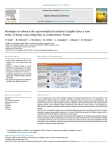Stark F., Mettauer R., Ryschawy J., Grillot M., Cassagnes A., Shaqura I., Moraine M. (2026). Strategies to advance the agroecological transition: insights from a case study of sheep-crop integration in southwestern France. Agricultural systems, 01/01/2026, vol. 231, p. 104514.
https://doi.org/10.1016/j.agsy.2025.104514
https://doi.org/10.1016/j.agsy.2025.104514
| Titre : | Strategies to advance the agroecological transition: insights from a case study of sheep-crop integration in southwestern France (2026) |
| Auteurs : | F. Stark ; R. Mettauer ; J. Ryschawy ; M. Grillot ; A. Cassagnes ; I. Shaqura ; M. Moraine |
| Type de document : | Article |
| Dans : | Agricultural systems (vol. 231, January 2026) |
| Article en page(s) : | p. 104514 |
| Langues : | Anglais |
| Langues du résumé : | Anglais |
| Catégories : |
Catégories principales 06 - AGRICULTURE. FORÊTS. PÊCHES ; 6.4 - Production Agricole. Système de ProductionThésaurus IAMM SYSTEME DE PRODUCTION ; AGROECOLOGIE ; TRANSITION AGROECOLOGIQUE ; ELEVAGE ; OVIN ; DIVERSIFICATION ; LANGUEDOC ; FRANCE |
| Résumé : | Context: Mediterranean areas face multiple challenges, including biodiversity loss, soil degradation, and vulnerability to climate change. In southern France's Languedoc region, vineyard monoculture dominates, and livestock systems are rare. Agroecological transitions, especially crop-livestock integration, offer opportunities to diversify systems, recycle nutrients, enhance biodiversity, and reduce fire risks. However, such integration is difficult due to climatic constraints, land accessibility, and the current disconnection between crop and livestock systems. Objective: This study aimed to explore how crop-livestock integration practices in the Minervois territory could be expanded to support agroecological transitions. It focused on identifying synergies that address forage needs for local flocks and create benefits for vineyard and cereal farmers. Methods: As part of a larger participatory and locally grounded approach, we designed agroecological scenarios based on integration of sheep farming system with various crop and semi-natural areas. We assessed the potential to reintroduce livestock in an area where few systems have existed recently. The process identified both the biotechnical and coordination conditions required to sustain livestock with local forage throughout the year and to organize exchanges among stakeholders. Results and conclusions: Except under dry conditions, a flock of 1200 ewes could be sustained year-round through a diversified landscape combining cereal crops, vineyard inter-rows, local rangelands, and transhumance (i.e., moving the flock from one territory to another to graze available forage resources). This diversity enhances agroecological performance through crop-livestock complementarities by exploiting synergies between animal and plant species, over time and space. The method used can be adapted to other territories, and stakeholder involvement is essential for developing understanding and implementing feasible scenarios Significance: The results support future studies aiming to link forage availability with organizational strategies to identify grazing areas and develop concrete implementation plans. |
| Cote : | En ligne |
| URL / DOI : | https://doi.org/10.1016/j.agsy.2025.104514 |







